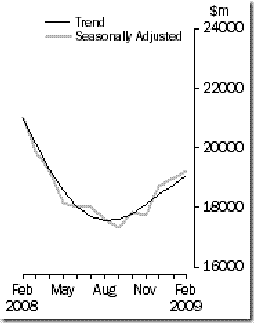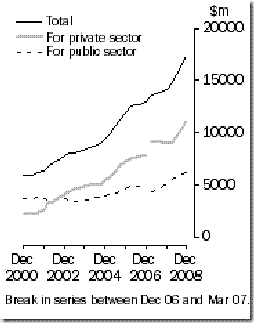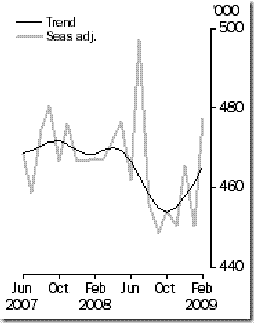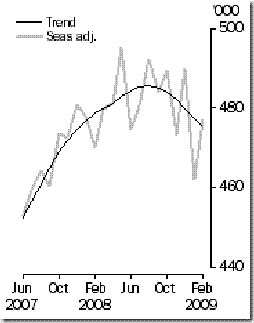The twists and turns associated with the global economic crisis remain fascinating. Perhaps the most interesting thing beyond the economics itself are all the by-plays and sometimes unexpected side-effects.
This post is simply a meander through some of the things that I have noticed or that have amused me. As a meander, it's probably going to be a bit disconnected. Still, I hope that it will be of some interest.
In On-ground effects of the Australian Government's stimulation packages - March 2009, I noted the market impact of the increased first home-buyers grant on house prices at a regional level. In an interesting article in today's Sydney Morning Herald, First-home rush keeps prices on boil, Elicia Murray, Ellie Harvey and Josephine Tovey report on similar effects in Australia's largest metropolitan marketplace.
Apart from continuing the apparent disconnect between Australian and broader global developments, this must be one of the few places in the world presently experiencing a mini-real estate boom, the current situation poses an interesting challenge to the Federal Government. Will the Government be forced to continue the measure beyond 1 July?
Like a fair few commentators, I expressed reservations when this measure was announced. The original introduction of the first home-buyers grant had a somewhat similar market impact - prices at the lower end of the market rose sharply and then stabilised at a higher level that took the grant into account. The effects were actually quite distorting, arguably disadvantaging lower income renters in particular.
This time the extra grant on the purchase of existing houses is time limited. The Government obviously hoped that this would stabilise house prices at a time when world news was dominated by crashes in asset prices. It may have got more than it bargained for. Economics 101 suggests that the present mini-bubble is likely to be followed by falls in house prices once the additional stimulus is withdrawn.
The case illustrates the difficulty Governments' face in crafting integrated measures in the face of lags and uncertainties.
Before going on, the Australian Government has created a web site to promote its economic stimulus package. Unfortunately it does not cover all the measures, so the best way to check back-details remains the Media Hub on the Prime Minister's web site.
The increased first home buyer arrangements were announced last October as part of the Economic Security Strategy. At the time, the focus was on an immediate response to the global financial crisis; the scale of the effects on the real economy were not then clear. Then as the crisis unfolded, a stream of new measures were announced.
The Government hoped that the various measures would work in an integrated way, cushioning the economy against immediate effects while allowing time for longer term measures to come into play.
It hasn't quite work this way. The flow-through into the Australian economy of the downturn was faster than expected. Then, for reasons that I have written about at length, the longer term measures have taken far longer to implement than the Government originally allowed.
The end result has been something of a disconnect between the measures. In this, the increased first home-buyers grant has actually become a bit of an orphan measure.
It addressed a problem (possible collapse in Australian asset prices) that, in retrospect, was not as great as the Government feared. Further, economic movements together with lags in other measures means that the impact of the end of the increased grant may stand out like a sore thumb.
There is another issue here.
The opposition's attacks on the Government's economic measures have centred especially on the increased debt burden that will remain as a legacy and have to be dealt with. While there is some truth in this, there is actually a much more significant problem that has already started to bite.
There was a very interesting article, unfortunately I did not keep the reference so cannot give proper credit, pointing to the impact of the various Australian Government treasury and finance departments. I thought that it was a very good article because it made a point that I had not thought about, but which rang very true from my own experience.
The point was a simple one. The various treasury departments accept short term deficits so long as the budget remains in balance in the long term, taking projected growth rates into account. Sounds simple, I can hear Australian readers saying Dur!, but it has important behavioural implications.
Quite simply, the knives are already out looking for places to cut spending to ensure budgets come back into balance. Here the current crisis provides an opportunity to do some pruning of things that would otherwise prove politically impossible.
We can see this in Treasury Secretary Ken Henry's speech yesterday foreshadowing changes to the welfare system. Among other things, the Sydney Morning Herald report states:
Dr Henry told a conference in Sydney yesterday that the pension and the public housing system discouraged people from joining the workforce.
Dr Henry is right, although the dynamics involved are beyond the scope of this post.
Accepting that I am taking Dr Henry out of context, he was speaking about reforms of the tax system, my point remains that the current situation provides an opportunity to introduce otherwise unpalatable changes.
There is, I think, a popular feeling that the current economic crisis provides an opportunity, indeed need, to spend. My point has always been that we need to spend wisely to minimise the loss of other opportunities a little down track.
One thing that has surprised me in recent economic developments has been not just the speed of transmission between countries, but more importantly the scale of the decline in certain activities.
The decline in car sales round the world, for example, has been far greater than could be justified on the simple indicators. We are dealing with a crisis driven by a consumer strike. In micro-economic terms, demand curves have shifted.
The Australian trade figures released during the week can only be described as quite remarkable.
Focusing first on imports, in February imports fell by one per cent in seasonally adjusted terms, two per cent in trend terms. Yes, Australian consumers too have partially joined the consumer strike (imports of consumption goods were down 13%), but this was largely offset by increases in other areas.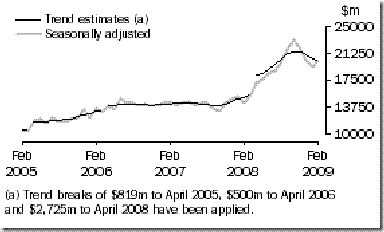
Think about it for a moment.
Around the world, imports have collapsed, mirrored by collapsed exports. In Australia, and as shown by the attached graph, imports are down, but not by all that much.
Turning to exports, in trend terms our exports were down by just 2%, up 4% in seasonally adjusted terms.
Australia's good trade performance was driven in part by a big increase in gold exports. However, Australia's rural exports also rose by no less than 6%. This is mirrored in New Zealand, I do not have the link, where agricultural exports also showed improved performance.
Very early, I focused on Australia's international trade position as the single most important determinant in the country's ability to ride out the global economic storm. Here I suggested that Australia's trade position had turned round at just the time required to help through the downturn.
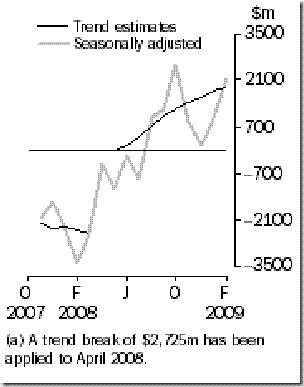 If we now look at the overall position, and taking into account major adjustments to previous estimates that make the detailed changes a little difficult to interpret, the ABS graph of the balance of trade on goods and services shows just how well Australia has done.
If we now look at the overall position, and taking into account major adjustments to previous estimates that make the detailed changes a little difficult to interpret, the ABS graph of the balance of trade on goods and services shows just how well Australia has done.
Reflecting Australia's trade performance, the Australian dollar has risen from a bottom of 57 cents US to 70 cents US.
I thought that 57 cents was absurd taking the fundamentals into account, although it gave the country a rather nice buffer. Seventy cents? Mmm, here I am less confident.
I am in the business of explanation, not forecasting. The next crunch point will come with the ending of current export contracts for some key commodities this month. This is the point at which the Access Economics doomsday scenario is meant to come into play.
I can't really comment without detailed checking of the figures. That said, at this point my feeling is that Australia's trade performance has given us a very real cushion. A $5 billion monthly deterioration, a huge change, will now simply take us back to where we were in the early part of 2008.
Australia remains the lucky country.
I am out of time.
I had intended to finish by discussing some of the shifts in the global economic tectonic plates, but this will have to wait.
